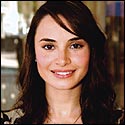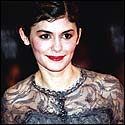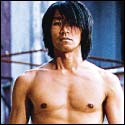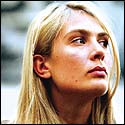
It all started as so much innocent post-vacation banter. A member of the staff had gone to Buenos Aires and come back impressed by, among other things, the striking handsomeness of the people he saw on the streets there. It was a distinct physical beauty that could in no way be confused with that found in other cities, he said; these people were Buenos Aires gorgeous, not Rome gorgeous or L.A. gorgeous. And from there a discussion ensued, naturally, about our own city, whose rich cultural and commercial treasures are often eclipsed by the incredibly satisfying passive entertainment called people- watching. A debate began; a story emerged. Could we really define New York beauty in 2005?
Our task, we soon realized, was like the one presented to the man in ancient Greece who was asked to paint Helen of Troy, the most beautiful woman in the world. He soon discovered that the project was impossible, because when he looked around for a model he could find no single woman beautiful enough. Eventually, he gave up looking and constructed his Helen out of pieces—this one’s toe, that one’s hand, the lips, brows, eyes of others. She was so perfect, you couldn’t see the joins.
You might use words other than impossible to describe our quest for the most beautiful man and woman in New York. Like ridiculous. Elitist. Disgusting. Cheesy. You might ask: Who would be so vain as to agree to be photographed? Why is my boyfriend/mother/wife/child not in there? All perfectly legitimate; we don’t expect you to cut these people out and put them on your wall or in your family album—we’re happy if you argue with the choices on display here, if you use them to think about how they exemplify New York’s particular brand of beauty. This is not a real list or a ranking of any kind. In fact, we amended the selection process a couple of times in midstream as the sheer absurdity of our task became clear. (See “How We Found Them” for an explanation and humble defense of our “methodology.”) Our improvised system did, however, yield a thought or two. Ask any New Yorker what he thinks makes a New York beauty, and one of the first things he’ll say is “diversity.” Can you find real diversity in a single person? Only rarely. But look at the people in these pictures: a platinum-blonde heiress, an African-American waiter, a corkscrew-curled redhead, a white-bearded artist, a Cuban-American couple, actresses in their thirties and nineties. These (among other, less genetically blessed mortals) are just some of the types you might see crossing the street. Imagine them not as a series of competing individuals—“New York’s Next Top Model”—but as a composite. It’s not a perfect image; you can see the joins, and that’s the point. New York embraces a wide spectrum of the beautiful—from the corn-fed blonde who’s just escaped from Kansas to the Caribbean beauty now living in Queens. We are a city of émigrés, living in what David Dinkins called a “gorgeous mosaic.” That includes not just ethnic differences, but also idiosyncrasies—in New York, we admire the odd, the off-kilter, the interesting design of a face.
So if the Greek painter was disappointed to find that beauty existed only in scattered details, an artist hoping to portray the most beautiful person in New York would now celebrate that fact.
New York is not just full of beautiful people, it’s full of beauty professionals. If a number of the people selected here look like models, it’s because that’s part of who ordinary people in New York are. Carolyn Benitez, who owns Coffee Shop in Union Square, hires models as wait staff because she was once a model herself and knows what it’s like to have to make money to put your book together. She happens to have a pretty spectacular eye. Models make sense for her restaurant because, she says, the city is “the beauty capital. I mean, it’s about the models, right? Good-looking, smart kids from other places.” Butterfly Boualaphanh, who works at the DNA model agency, says that when scouting for models, “if I’m somewhere else, I say, ‘Have you thought about modeling?’ In New York, it’s ‘What agency are you with?’ ”
Nevertheless, there is a far wider variety of New York beauty than you’ll find in fashion magazines and advertising campaigns. Kim Hastreiter, editor of Paper magazine, believes that to be beautiful here you have to be a maverick. “Models aren’t beautiful to me,” she says. “Models are just for putting clothes on. It’s about character, and I think America promotes models that have very little character or diversity.” This is not because ideas of beauty are set in stone—recalling a particularly memorable fashion campaign from a few years back, Hastreiter refers to what she calls “the village-idiot look. There’s definitely an inbred look of beauty.” But the runways, she says, “looked a lot different when Bethann was in charge.”
Bethann is Bethann Hardison, who changed the face of the fashion industry as a black model in the sixties and seventies, and as a model agent later on. She made the careers of Veronica Webb, Talisa Soto, and Ralph Lauren poster boy Tyson Beckford, and was “like a coach” to Naomi Campbell. Although Hardison thinks that now, in New York, you’re exotic if you’re Caucasian, she still agrees that “the idea of beauty has remained the same, no matter how much influx, no matter who is buying, who is living next to you, or how many people walk past you on the street.” After she closed her agency in 1996, people told her the modeling business was slipping without her. “I didn’t want that responsibility,” she says. “The New York Times interviewed me and they wanted to know what was going to happen to all the people I’d helped. And that, at the time, was people of color. And I was like, they’re fine, they’re gonna be fine. And honey, little by little, it has died.”
Who wields the power in this scenario? Some will cite American Vogue, or the photographer Steven Meisel, or whatever’s going on at Prada. On the other hand, it seems to be more unpredictable than that. Boualaphanh offers an explanation that sounds like a recipe for anxiety: “Every season there’s a new group of girls that’s coming out. It’s not like the late eighties, when you only had six major girls who would do every show, every campaign, every catalogue. So everybody’s looking for something new. What’s the hot new thing? No one knows.” She thinks for a moment. “I guess beauty is in the eye of the beholder, right? That’s what they say.”
That is what they say. All the time. But they don’t mean it. That’s just a myth people cling to, because even in the beauty industry, they’re embarrassed to be talking about the surface of things all the time. Scientific research suggests that there is an automatic, universal standard of beauty. It has to do with the qualities of “order and symmetry” identified centuries ago by Aristotle. In one study, two American anthropologists presented a multicultural set of female faces to five groups of people in Brazil, the United States, Russia, and two isolated tribes of Indians in South America. There was a surprising amount of agreement on which faces were beautiful: those who had similar geometric proportions—large eyes in relation to a small jaw. The supermodel Paulina Porizkova got it right when she said that people finding her beautiful was really “a matter of mathematics: the number of millimeters between the eyes and chin.”
A lot of cities make a spectator sport of their street life. What distinguishes New York’s are the extremes of self-awareness that go along with it.
But are perfect proportions really what make you turn your head when you see a beautiful person on the street in New York? Sometimes, yes. Just as often, though, we respond to variety, to looks we haven’t seen before. As the fashion designer Isaac Mizrahi puts it, “People in New York are like works of art. They make and exhibit themselves every day.” In addition to the models on Mulberry Street, we are entranced by skateboarders at Union Square, socialites teetering on a fuchsia carpet for the opening of a meatpacking-district boutique, and disheveled hipsters stumbling out of their Williamsburg apartments late on a Sunday morning. Each one is a masquerade. However nonchalant they may look, these people are playing to the spectator sport that is New York City street life.
Every city has street life of some kind. What arguably distinguishes ours are the extremes of self-awareness that go along with it, as well as the constant flux. In a city like Rome, there is a very particular look that dominates, a blend of style and physique; the prevailing aesthetic changes almost not at all. Italian women (and men) tend to favor long, slightly messy hair that they push around impatiently. The women play up their hourglass figures—the heirs of Sophia Loren and Anna Magnani, they allow their gesticulations to become an extension of their looks. In Paris, for women, it’s seen as almost impolite to veer from the perfectly groomed, skirt-suited norm. Anyone who does is condemned to look like a perennial teenager. For men, in their narrow-cut suits, the look hasn’t changed since 1968. In London, which can rightfully claim its own rebel-beauty heritage (from Mary Quant to Sid Vicious to Alexander McQueen), the streets are now full of men and women with Hershberger-ized haircuts and Seven jeans. They all seem like Manhattanite impersonators.
In New York, of course, you hardly notice those people anymore. New Yorkers want to stand out. They’re constantly reinventing their appearance. They know you’re looking, and they’re looking right back.
If beauty has become more democratic, as some argue, one reason is that it can now be easily bought. Elaine Showalter, author of The Female Malady, suggests that “there is a feeling now that anyone can be beautiful who makes the effort, that beauty in a sense is a right. Now, is this a good thing or a bad thing? In some ways, it does democratize beauty. And if beauty is, as all the polls say, a major factor in success, then everybody at least has a crack at it. On the other hand, the beauty stakes continually go up, and once it’s democratized, then finer and finer distinctions are made. It seems to me that every year there’s a new part of the body that’s offered up for correction, and you never knew it had standards. What body part is immune? Since the bikini wax, as far as I can tell, none.”
The July issue of Italian Vogue contains a photo-essay by Steven Meisel that is the talk of the beauty business. Over 80 beautifully laid-out pages, Linda Evangelista checks in for plastic surgery. She is wearing spectacular clothes—a black Moschino suit, a Lanvin dress—smoking as she waits on the operating table, talking on her cell phone as her legs are waxed and lipo’ed simultaneously. So far, so glamorous: The bandages around her head and chin are made to look like the kind of thing André Courrèges might have designed in 1964. But the final frames show Evangelista—and if there were a single most beautiful woman in the world, she would be her—out cold under the knife. Her neck area is blotchy, reminiscent of the terrible photos of Marilyn Monroe’s corpse. Blood is seeping from cuts around her jaw and eyelids. She looks both dead and full of bright life, as if decorated for some new form of Kabuki theater.
The point of these photographs is not that they show the gory truth behind plastic surgery—though, of course, for some readers of Vogue, they might. The point is that it’s just another form of makeup. The essay (subtitled “Between Art, Realism and Irony”) constitutes some kind of happening, a fashion “act,” along the lines of the work of performance artist Orlan, who wore Issey Miyake for real facial surgery performed by doctors in Paco Rabanne gowns and relayed the procedure live by satellite into art galleries all over the world. It’s beauty against beauty, and it makes you wonder: What does beauty want to say about itself?
The influential makeup artist James Kaliardos says that “if you’re too polished or Botoxed, it just doesn’t work” in New York, that the city has “a harder, more honest edge,” and that New Yorkers have “a quick, unlabored approach to beauty.” Isaac Mizrahi says that when he was a kid, he always liked the idea of growing old in New York because he’d “always noticed gorgeous-looking old people on the street more than gorgeous young people. That seems truer lately because it seems to me that the least sexy-gorgeous person is one of those dime-a-dozen sexy, gorgeous, young things you see at those B clubs in high heels and bias-cut satin dresses. The most unsexy guy is one of those ‘sexy’ ones with giant muscles and a tan.”
A recent poll found that while only 2 percent of women worldwide said they thought of themselves as beautiful, 90 percent of women in the U.S. said their looks were average or better. There are only two possible explanations: either Americans are more narcissistic (or possibly just more honest) than the rest of the world—or that poll was conducted in New York City.
Indeed, if you glance at the personal ads online and in New York papers and magazines, there is remarkably little demand for beauty per se, maybe because we take it for granted. Though you might find the odd request for a “flexible body” or an “Olivia de Havilland look-alike,” what we seek is generally based on what we think of as character, however superficially rendered. “Intellectual type”; “bookish nerd seeks slightly sexier bookish nerd”; “art vixen”; “passionate, extraordinary, affluent gentleman”; “bad girl gone good”; “guy w/access to dirty panties”; “woman w/cultural ints & human frailties.”
Most New Yorkers, if pressed, would concede that they love living in a city where they are surrounded by so many stunning faces and stylish ways—even if that fact causes us, on occasion, to run home screaming, spasmodic wrecks of inferiority and anxiety. We take pride in the city’s human splendor. It is one of our attractions, like skyscrapers and good restaurants and intelligent talk.
Still, this is somehow hard to confess. We are taught that where romance is concerned, looks are unimportant. Every novel, every screwball comedy evokes a meeting of minds. The phrase “meeting of looks” does not exist. But how many couples do you know who reflect each other’s appearance?
I know a couple who met some years ago at Coffee Shop in Union Square. She was a waitress there and a model. He went for lunch and to look at her. She was Russian, he was English. Yet they shared such identically chiseled faces, it was a wonder they didn’t cut themselves when they eventually kissed. Although they couldn’t really speak to each other, they fell in love and he paid for her to have English lessons. Then he asked her to marry him, and they were still happily together the last I heard. Sometimes beauty is enough.

We asked local experts to describe their city’s look and to pick a person who embodies it.

Mia Maestro
Buenos Aires
“There are four types of beauty here: high cheekbones, green-blue eyes, and olive skin; interesting noses and strong, dark hair from our Spanish roots; wide-set eyes and shorter, more muscular bodies from indigenous tribes; and pale skin and ash-blonde hair from the Eastern European community.”
—Simona Martinez Rivero, fashion editor, Elle Argentina


Audrey Tautou
Paris
“There is a definite Parisienne, who is five four and weighs 116 pounds. She’s wearing a tight little skirt and very high heels. She’s walking very fast, talking into her cell phone, and her hair was done today. She’s either blonde with black eyebrows or dark-haired, and it’s shoulder-length.”
—Joan Juliet Buck, writer and former editor of French Vogue


Stephen Chow
Hong Kong
“The beauty of Hong Kong is that people are not just Chinese. They are a hybrid of West and East. They know how to dress—trendy, but a little bit more conservative than New Yorkers. Casual elegant. You can tell from their eyes that they are very streetwise.”
—Tony Leung, actor


Lavinia Borromeo
Milan
“The Milano beauty has blonde hair, makeup, very bourgeois, elegant, but conservative. She’s very thin because she goes to the gym. She’s fair, with light-colored eyes. Rome is almost the opposite. You have to be sexy and you have to be seen. Everyone is nude, even in the wintertime.”
—Franca Sozzani, editor-in-chief, Italian Vogue
